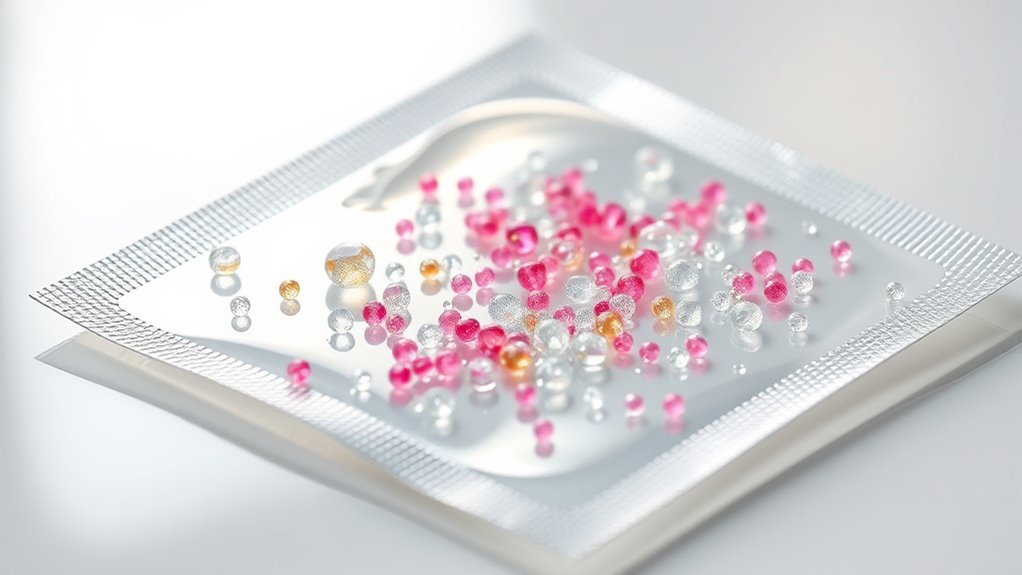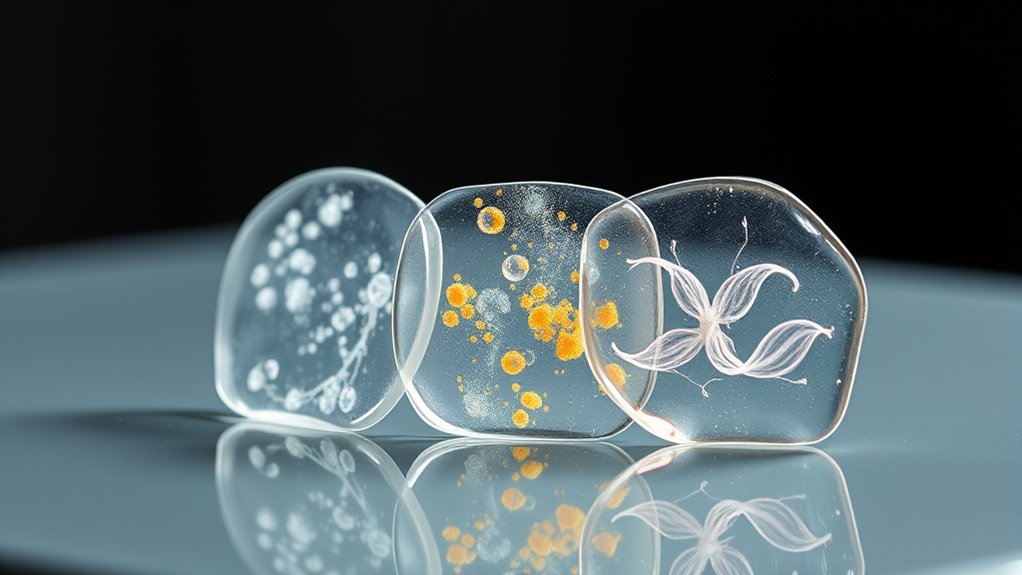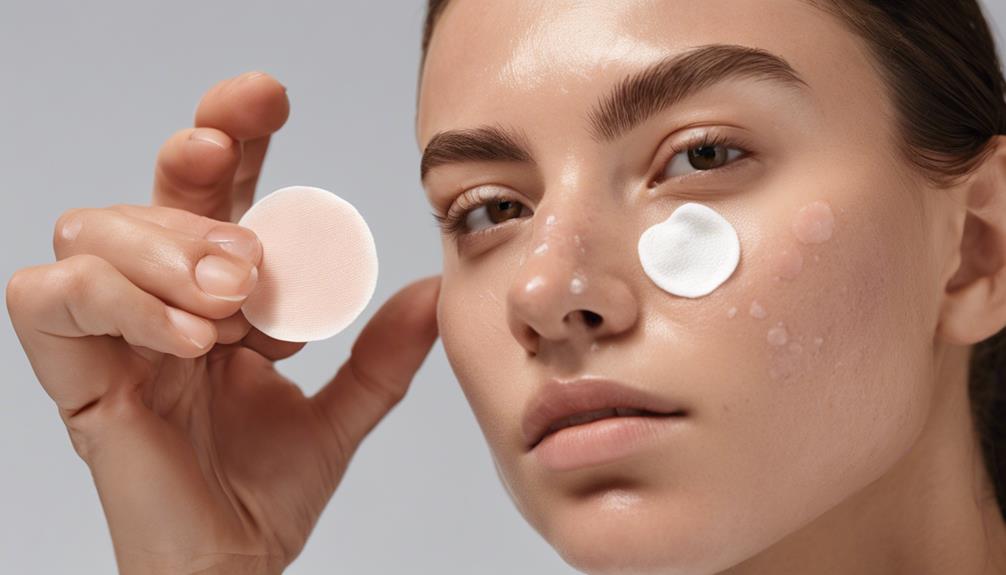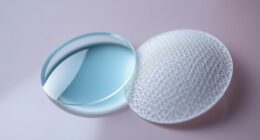Skincare patches contain active ingredients like hyaluronic acid, niacinamide, and peptides that penetrate your skin more effectively than creams. Hyaluronic acid helps boost moisture and plump your skin from within, while niacinamide reduces pores and evens out your tone. Peptides stimulate collagen production, improving firmness and reducing fine lines. These targeted ingredients deliver quicker, visible results by reaching the deeper layers of your skin. Keep exploring to discover how these components work together for your best skin.
Key Takeaways
- Skincare patches effectively deliver active ingredients like hyaluronic acid, niacinamide, and peptides directly into deeper skin layers.
- They use adhesive technology to ensure targeted, sustained release and better absorption than traditional creams.
- Hyaluronic acid in patches boosts deep hydration, maintaining skin plumpness and preventing moisture loss over time.
- Niacinamide delivered through patches reduces inflammation, minimizes pores, and evens skin tone for clearer, smoother skin.
- Peptides in patches stimulate collagen production, enhance elasticity, and improve skin firmness more efficiently than topical applications.

Skincare patches have gained popularity for their targeted delivery of ingredients directly to your skin. This delivery method guarantees that active compounds reach their intended layers efficiently, often resulting in better absorption compared to traditional creams or serums. When you apply a patch, it acts as a reservoir that slowly releases ingredients over time, optimizing ingredient absorption and minimizing waste. This focused delivery method not only enhances effectiveness but also helps you avoid unnecessary exposure to preservatives or fillers found in other products.
The way skincare patches deliver ingredients is vital for their performance. Unlike topical creams that rely on passive diffusion, patches use a combination of adhesive technology and specialized formulations to penetrate the skin’s barrier more effectively. This method allows active ingredients to bypass some of the superficial layers and reach deeper tissues where they can exert their full benefits. As a result, you notice faster and more noticeable improvements, especially with ingredients like hyaluronic acid, niacinamide, and peptides, which have specific roles in skin health.
Hyaluronic acid, for example, is renowned for its ability to hold water and hydrate your skin. When delivered via patches, its molecules can penetrate more deeply, boosting moisture levels from within. This targeted delivery prevents surface-level evaporation and ensures your skin stays plump and supple longer. Niacinamide, a form of vitamin B3, works by reducing inflammation, minimizing pores, and evening out skin tone. Because patches deliver it directly where it’s needed most, you get clearer, smoother results faster, without the dilution or degradation that can happen in other formulations.
Peptides, small chains of amino acids, stimulate collagen production and improve skin elasticity. With dedicated delivery methods, patches help these fragile molecules penetrate the skin barrier more effectively than topical creams, which often struggle to deliver larger molecules efficiently. As a result, you’ll experience increased firmness and a reduction in fine lines more rapidly. The combination of these ingredients in patches means you’re maximizing their potential, with each component reaching the right depth at the right time. Additionally, understanding skin barrier function helps explain why targeted delivery can enhance ingredient efficacy and skin health over time.
Frequently Asked Questions
Are Skincare Patches Suitable for Sensitive Skin Types?
Yes, skincare patches can be suitable for sensitive skin if you choose the right ones. Look for patches labeled as “patch compatibility” with sensitive skin, and check for soothing ingredients like hyaluronic acid or niacinamide. Always do a patch test before full application to prevent irritation. If you notice redness or discomfort, remove the patch immediately and consult a dermatologist. This way, you can enjoy benefits without skin issues.
How Long Should I Wear a Skincare Patch for Optimal Results?
For ideal results, you should follow the duration guidelines provided on the patch packaging. Typically, patch application lasts between 8 to 24 hours, depending on the product. Avoid leaving it on too long, as it may cause irritation or reduce effectiveness. Make sure to clean your skin beforehand, apply the patch as directed, and remove it once the recommended time is up to maximize benefits and prevent any skin issues.
Can These Ingredients Cause Allergic Reactions or Irritation?
Did you know that up to 20% of skincare users experience allergic reactions or skin irritation? These ingredients, like hyaluronic acid, niacinamide, and peptides, are generally safe, but they can cause allergic reactions in sensitive individuals. You might notice redness, itching, or swelling. Always do a patch test before full application, and discontinue use if irritation occurs. Consult a dermatologist if you’re unsure about how your skin will react.
Are Skincare Patches Effective for Deep Wrinkles or Only Surface Issues?
Skincare patches can provide effective surface issue remedies, but they may not be the best deep wrinkle treatment. If you’re targeting deep wrinkles, you’ll want products specifically formulated with ingredients like retinoids or peptides that penetrate deeper. Patches can improve skin texture and hydration on the surface, but for significant wrinkle reduction, consider combining them with treatments designed for deep wrinkles. Always consult a dermatologist for tailored advice.
How Often Should I Use Patches Containing Hyaluronic Acid, Niacinamide, or Peptides?
Think of your skin as a garden that needs regular tending. For patches with hyaluronic acid, niacinamide, or peptides, applying them 2-3 times a week works best, like watering your plants. Use them after cleansing and before moisturizer, ideally in the evening or morning. Consistency is key—adjust frequency based on your skin’s response, ensuring the nutrients nurture your skin without overwhelming it.
Conclusion
Skincare patches are revolutionizing how you deliver ingredients like hyaluronic acid, niacinamide, and peptides directly to your skin. Did you know that the global skincare patch market is expected to grow at a CAGR of over 8% through 2027? This shows their rising popularity and effectiveness. So, next time you want targeted skincare, consider patches with these powerful ingredients—they’re convenient, efficient, and designed to give your skin the boost it needs quickly.








